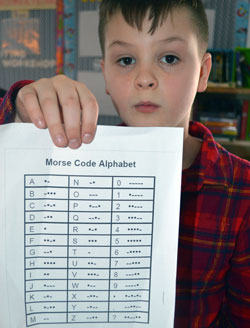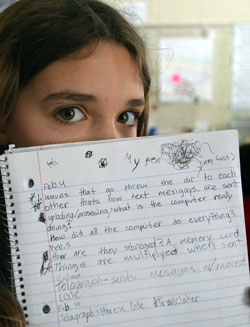It began with a question in Colleen Heyboer’s fourth grade class: when people transfer photos and videos using their cell phones, how exactly does that happen?

“It has something to do with the cloud,” reckoned Tatum VanRavenswaay.
Indeed. And that’s, well, about as much as a lot of people know. Heyboer’s students made short videos explaining the step-by-step process of air-dropping, beginning with Step 1: turn on your cell phone, and so on. But Heyboer wanted her class to understand the transfer of information on a binary level.
Before diving into digital binaries — the 1s and 0s that make up that mode of communication — Heyboer thought it would be helpful to learn Morse code, an early form of binary communication. Transmitted via telegraph and lighthouse, those are the dots and dashes most well known for the emergency distress message SOS — a sequence of three dots, three dashes, then three more dots.

“It’s what they used to use instead of texting,” explained Camryn Vroma.
First, students learned Morse language by playing Simon Says. Next, they worked in groups to build their own transmitters and receivers.
“It’s incredible,” said Heyboer, who is teaching it for the second year. “I had to learn it all too, before I could teach it. And I’m just as excited as they are.”
Hard and Soft Skills
The Morse code lesson was part of a four to six-week unit on waves and communication, which is part of Michigan Science Standards. Computer coding comes next, then it will be onto the study of sound waves.

Heyboer taught middle school science for nine years before coming to West Oakview. She and high school science teacher Erin Berryhill share the role of district science curriculum teacher leader and trainer.
“The science is only a third of the process. It’s really based on thinking and figuring things out,” Heyboer said. “We want them to be thinking and doing things that scientists actually do. (During the unit) they’re being presented with problems and trying to focus on solutions rather than just learning the science concepts.
“And they focus on science and engineering practices to develop and use models that they get peer feedback on, and make changes throughout the whole unit.

“We talk about how we’re always learning new things, and how our thinking can always evolve and be changed.”
Heyboer talks about her students’ enthusiasm, including that of special-education students who struggle to read at grade level but are every bit as proficient with the hands-on learning.
“The excitement is just really cool,” she said. “They’re talking in Morse code in the lunchroom. They have this secret language they’re using now, and it’s reaching all students. It’s very inclusive learning.”











